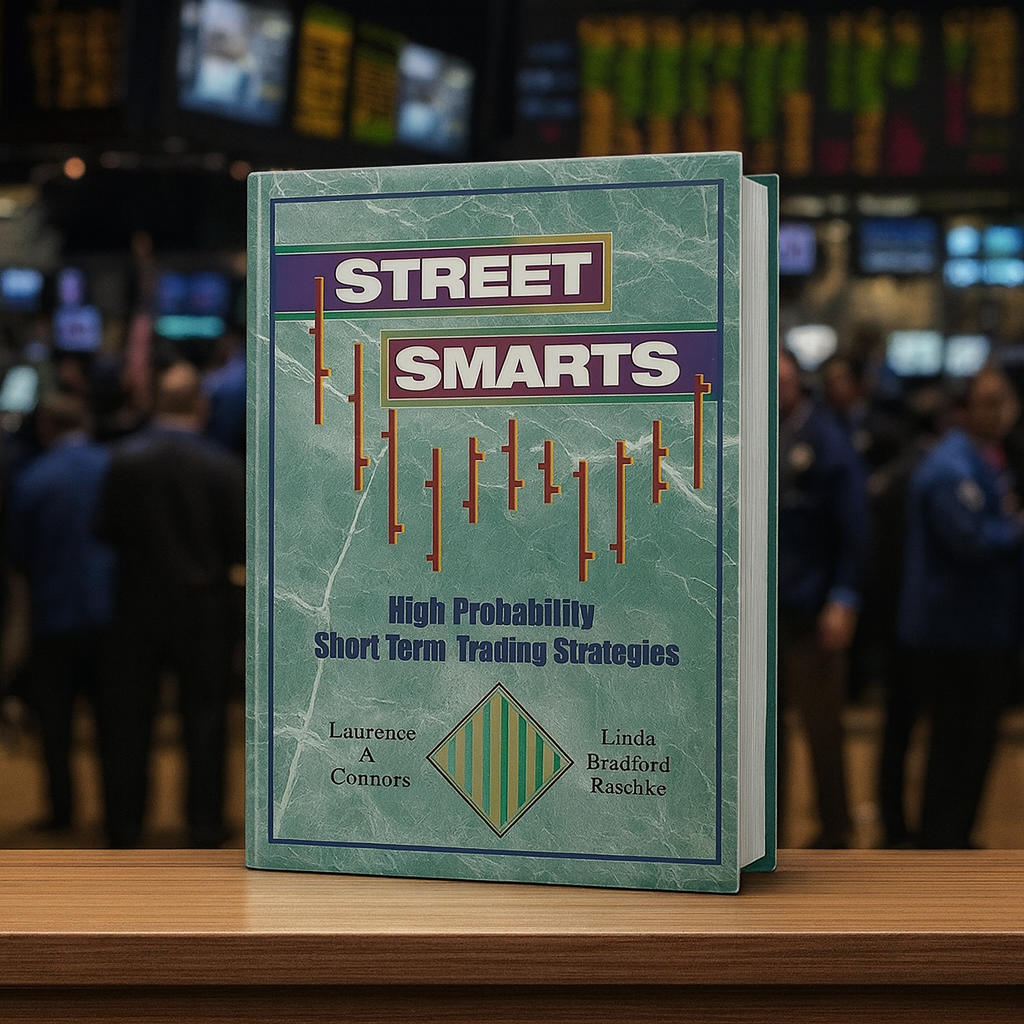Street Smarts trading strategies teach clear, rules-based setups—like fading failed breakouts—to boost consistency and protect capital. Rooted in market psychology and written plainly, it helps new traders focus on process over prediction; see how to adapt the ideas to your timeframe.
When traders talk about “market legends,” Linda Raschke’s name often comes up. A former floor trader turned market educator, Raschke co-authored Street Smarts: High Probability Short-Term Trading Strategies with Laurence A. Connors in the 1990s—a time when most trading wisdom passed by word of mouth or expensive seminars.
Three decades later, this book remains a favorite among short-term traders, not because it’s filled with theories or abstract models, but because it teaches something timeless: how to recognize patterns in price behavior and act with discipline.
For today’s investor—whether someone exploring technical analysis for the first time or a trader seeking to refine their strategy—Street Smarts still matters. It bridges the gap between intuition and structure, showing how even short-term trades can follow repeatable, testable setups rooted in market psychology.
Core Ideas
At its core, Street Smarts is a playbook of trading “patterns”—repeatable price setups with defined entry, exit, and risk management rules. The book’s strategies include well-known formations such as the Turtle Soup, Anti, and Whiplash, which are designed for traders who operate on daily or intraday charts.
Rather than relying on indicators or complicated formulas, Raschke and Connors emphasize context and behavior:
- How prices react after false breakouts.
- How trends often end with exhaustion spikes.
- How volatility compressions often lead to powerful directional moves.
The message is simple but profound: markets move in rhythms. By learning to read those rhythms—and by setting clear, repeatable rules—traders can create a process that removes emotion and increases consistency.
Each pattern is backed by historical testing and plain-language explanation. For example, the “Turtle Soup” strategy exploits failed breakouts by fading overly eager traders—a lesson in market psychology as much as price structure. The book doesn’t promise riches overnight; it promises a framework for thinking like a professional.
Strengths
1. Clarity and Practicality
The book stands out for its hands-on approach. Every strategy includes entry and exit examples, illustrated with charts that show exactly where a trader might act. Raschke avoids academic jargon. Instead, she uses relatable terms and stories from her trading floor days—moments when instinct, preparation, and risk control collided in real time.
2. Market Psychology Woven Into Strategy
What makes these setups powerful is not just their technical structure but their psychological insight. Many patterns are designed to take advantage of crowd behavior—how fear and greed repeatedly create predictable traps. This is especially valuable for beginners, who often struggle to understand why markets behave irrationally.
3. Timeless Lessons
Despite being published decades ago, the principles remain valid. Markets evolve, but human behavior does not. Whether one is trading stocks, futures, or currencies, the same emotional patterns—panic selling, euphoric buying, and false breakouts—still drive price movement.
4. Emphasis on Risk and Process
Unlike many trading books, Street Smarts is not about “winning trades.” It’s about building habits: defining risk before entry, maintaining consistency, and treating trading like a business. Raschke’s own discipline—rooted in years on the trading floor—shows readers that successful trading is less about prediction and more about preparation.
Limitations
1. Short-Term Focus
The strategies cater mainly to active traders. Long-term investors or those seeking fundamental analysis will find little here about company valuations or macroeconomic trends. This is a tactician’s manual, not an investor’s textbook.
2. Old Charts and Market Context
Because the book was written in the mid-1990s, the charts and examples reflect older market structures—before algorithmic trading, ETFs, and today’s 24-hour global flows. Some setups might require adaptation for modern volatility conditions or electronic markets.
3. Learning Curve for Beginners
Although written in plain English, the concepts assume that readers already know how to read price charts, place orders, and understand risk management. Beginners may need supplementary resources to fully grasp the nuances of position sizing and execution.
4. Limited Data Depth
While Connors and Raschke discuss historical testing, the statistics are brief compared with today’s data-driven analysis. Modern traders who expect detailed backtesting reports may find the evidence more anecdotal than quantitative.
Trader’s Takeaway
Street Smarts is not a “read and get rich” book—it’s a manual for structured thinking in short-term trading.
Here are its core takeaways for everyday traders and curious investors:
- Pattern Recognition Over Prediction: Instead of guessing market direction, focus on identifying recurring setups—just as a chess player recognizes board positions that favor specific tactics.
- Failing Breakouts Are Opportunities: Markets often trap traders chasing breakouts. Raschke’s “Turtle Soup” strategy teaches how to fade these traps and profit from reversals.
- Discipline Beats Genius: Even a simple strategy can outperform intuition if executed consistently. The book shows how to systematize decisions to avoid emotional trading.
- Risk Comes First: Every strategy in the book includes clear stop-loss placement. The authors reinforce that protecting capital is the first rule of trading longevity.
- Adapt, Don’t Copy: The point isn’t to copy Raschke’s methods line by line, but to understand the logic behind them—and then test and adapt them to one’s own style, time frame, and market.
For retail traders, these lessons translate into actionable habits: journal your trades, track setups, measure risk, and keep your methods simple enough to repeat under pressure.
Who Should Read
This book is ideal for:
- Aspiring or active traders who want to understand how short-term strategies work in real markets.
- Finance students and hobbyist investors who prefer practical insights over theory.
- Technical analysts looking to study classical price patterns still relevant today.
- Experienced investors curious about how professional traders approach market timing and execution.
However, long-term investors focused solely on fundamentals or passive portfolio management might find it less relevant, as the book’s time horizons are measured in days, not years.
Verdict
Street Smarts: High Probability Short-Term Trading Strategies remains one of the most readable and practical trading books ever written. Its power lies not in complexity but in clarity—the way Raschke turns market behavior into a learnable craft.
It reminds readers that trading success isn’t about secret formulas; it’s about recognizing human nature in price charts and following rules that keep emotions in check.
While some of its examples show their age, its principles—discipline, pattern recognition, and risk management—are timeless. For traders who want to learn how to think and act with structure, not just chase signals, this book is a quiet classic.
Summary Verdict:
A must-read for anyone serious about learning how real traders think, plan, and execute. Clear, grounded, and psychologically insightful, Street Smarts remains a benchmark for bridging intuition and discipline in the trading world.









